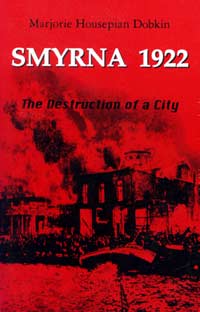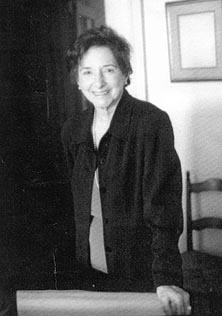 SMYRNA COMMEMORATIVE SERIES  |
|||
|
Marjorie Housepian Dobkin, Smyrna 1922: The Destruction of a City Newmark Press, New York (1988), Softcover, 275 pp ISBN: 0-9667451-0-8 By Christos and Mary Papoutsy
If genocide and ethnic cleansing are news headlines today, what then can a Greek-American reader glean from this volume by Marjorie Housepian Dobkin? A great deal. This particular event, the Smyrna holocaust -- or "catastrophe" as Greeks generally refer to it, has been ignored by western historians. Consequently, many Greek-Americans, especially those whose family roots do not stem from Asia Minor, are not familiar with the details of this massive human tragedy. Yet the politics and pathos arising from that time have greatly affected the collective Greek psyche, and indeed, the course of history for the entire Greek nation. This stunning and well-written book by Dobkin helps to fill the information gap for Greek-Americans and Greek generations of the Diaspora. To be sure, Smyrna 1922: The Destruction of a City is not the only text written about the Smyrna holocaust, but it is one of the most authoritative and critically acclaimed books ever penned on this subject. Professional reviewers speak in glowing terms about Dobkin's book. Here is a sampling of their remarks: "A poignant, meticulously documented chronicle of an all but forgotten tragedy. . .beautifully recaptures the flavor and richness of Smyrna in it's prime."--New York Times Sunday Book Review "A documentary indictment of the inhumanity of religion, the callousness of Powers and the avarice of commerce." --The London Sunday Times ". . .enlightening about the present day Middle Eastern situation. . .the deep emotional issues of the Cyprus problem
"Calculated to make a contemporary reader run screaming into the night. . .for its foreshadowing of similar attitudes in other places in the years to come. . .Miss Housepian tells her story well." --The Times Literary Supplement "A vigorous but restrained account. . .raises profound issues of historiography and diplomatic morality." --The Guardian " A creditable account of this critical period in the early postwar history of World War I in the Middle East. . .An important documentary." -- Howard Reese, naval historian, The Marine Corps Gazette. Dobkin masterfully details the atrocities committed by the Turks against Armenian and Greek Christians in Smyrna: the massacres, rapes, pillages, and finally, the torching of this vibrant, cosmopolitan city. In a few short days, this jewel of urbanity and education was reduced to ashes and bones, bringing to an end 3,000 years of continuous Greek history in coastal Asia Minor. Readers march along with Dobkin relentlessly, drawn into the terror of the events. Throughout her chronological sequence, the author provides reliable and credible substantiation as she rejects Turkish counterclaims and denials with the brilliant illumination of historical reality. Unlike many books about Smyrna which rely almost exclusively on eyewitness accounts, this author has include copious amounts of archival material from governmental sources in Washington and has tracked down accounts written by Christian missionaries, American military personnel, and impartial diplomatic officials. Carefully utilizing records of well-educated observers, Dobkin clearly builds a case of irrefutable culpability on the part of the Turks. For example, Dobkin cites American Vice-Consul Baines and other consular officials: "Eyewitness Report. Turkish soldiers often directed by officers. Throwing petroleum in the streets and houses. Vice-consul Baines watched a Turkish officer leisurely fire the custom house and the passport bureau. The American navy patrol reported seeing a complete horseshoe of fire started by the Turks around the American school." Another American observer whose remarks have been cited is George Horton, longtime diplomatic official in the Near East; in his diary of September 1922, Horton estimated that over 100,000 were lost at Smyrna. Dobkin's book was written at a critical period in history for political affairs in the Balkans and the Middle East. Of particular import are two issues at the forefront of Greek and Greek-American relations: Cyprus is scheduled to join the European Union shortly; the Turkish government seeks candidacy for entry into the European Union. Both of these issues are affected by the events of Smyrna in 1922, since Turkey steadfastly denies that any crimes against humanity took place in Smyrna. Moreover, she has attempted to coerce American lawmakers into refusing to recognize the genocide that has
With the advent of Smyrna 1922: The Destruction of a City and other such finely crafted, scholarly works, many of the world's most respected thinkers and academicians and authors have begun to speak out about Turkish revisionist attempts. In 1988, over 150 of such prominent individuals as Yehuda Bauer, Israel Charng, Seamus Heaney, Deborah Lipschadt, Arthur Miller, and Kurt Vonnegut took a stand against Turkey's multi-million-dollar propaganda campaign by signing a petition to affirm that this "denial of genocide is a form of aggression. It continues the process of genocide. It strives to reshape history in order to rehabilitate the perpetrators and demonize the victims. It prevents healing of the wounds inflicted by genocide. Denying genocide is the final stage of genocide—it murders the dignity of the survivors and destroys the remembrance of the crime." Due to the efforts of persons with integrity and courage, like Marjorie Housepian Dobkin, a renaissance is taking place worldwide about seeking the truth of the Smyrna Catastrophe. Organizations such as the American Hellenic Asia Minor Society, led by President Bill Ameredes, and the noted ESTIA group in Athens, funded by Onassis grants, work to promote the truth. This year New York State designated May 19 as Pontian Greek Genocide Remembrance Day, according to one of our Philhellenic friends. For Greek-Americans this book is a "must-read." Not only does it cover the Smyrna holocaust authoritatively, but it also sets the "catastrophe" within a wider pattern of genocide and ethnic cleansing in Asia Minor. The destruction of Smyrna was the final climax of Christian genocide for several decades, beginning with the Armenians, Assyrians, and Pontic Greeks late in the 1800s. Dobkin's investigations demonstrate a change in tactics used by the Turks upon advice from German allies early in the twentieth century, ushering in a new era of mass murder through deportations, forced death marches, and internment. Enhanced killing efficiency chillingly prefigured World War II death camps. Indeed, German complicity stains every page of this horrendous tale, with Turkish successes encouraging the Nazis and setting the stage for the Jewish Holocaust. The words of Adolph Hilter were revealing when he dismissed the Armenians, remarking that no one remembered them. Dobkin's book, then, not only informs Greek-Americans about the Christian holocaust of Smyrna, but also sets the tragedy within a larger historical context of racism and genocide, topics as relevant today as they were centuries ago. Readers will gain a firm understanding of the effects these horrendous events had on later conflicts in the Balkans and Europe. Clear, well-written, and eminently factual, Smyrna 1922: A Destruction of a City belongs in every library and on every history-course syllabus. Readers can obtain copies through booksellers on the Internet and by calling 212-662-4080. |
|||
|
(Posted December 2003) For more information about Smyrna or the Greeks of Asia Minor, see especially the HCS section at http://www.helleniccomserve.com/smyrnaopener.html. See also the Smyrna Commemorative Series by HCS at http://www.helleniccomserve.com/commemorativeseriesintro.html or browse articles in the Smyrna section of our site archives at http://www.helleniccomserve.com/archivesmyrnaasiaminor.html. 2000 © Hellenic Communication Service, L.L.C. All Rights Reserved. http://www.HellenicComServe.com |


